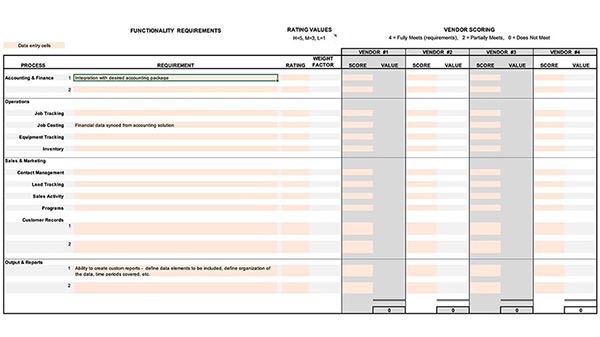As a kid, I absolutely loved Legos. Specifically, I loved the Space Legos — rockets, moon landers, space stations. If they could blast me off this Earth and start my space odyssey, I had to have them! One year my well-intentioned family bought me a City Lego set, and I found myself at a juvenile crossroads. How do I incorporate a city hall in the middle of my Mars outpost? Do I even need a fire station on Saturn?
As restoration professionals, I feel as though we often find ourselves in a similar situation when it comes to our software systems and the flashy new products that are brought to market seemingly week in and week out. How do we find time to filter through the options, incorporate a new platform into our existing system and settle on the right package that will set our company up for the future growth we are working so diligently toward? Here are a few suggestions from my own experience that you may find useful in your journey.
1. Stop looking for perfection.
I’m going to break it to you right now: The perfect software package does not exist, at least not yet. Every single software package on the market today is strong in one area and has some significant weakness in another. This one has an intuitive, easy-to-understand user interface that our frontline workers can master in mere days, but it lacks a strong scheduling solution. That one excels at project management and scheduling, but it has a lousy interface with our accounting platform. To date, I have not experienced a software solution that checks all the boxes. My suggestion would be to decide what your non-negotiables are and then don’t back down from those must-haves. Figure out where your business can realize the greatest benefits and align your choice in software vendor along those lines.
2. Know your starting point.
No matter how good the map, it’s hard to get where you are going unless you know where you currently are. Start by asking the right questions before you look at the shiny answers. Every software solution on the market (and those that currently exist only in someone’s mind) were developed out of the need to solve a problem. But the developer’s problem may not be the same as your problem. I am a firm believer that the solutions to my troubles start with the pieces of scratch paper I have littering my desk. They give me a rough sketch of what needs to be built before we hire a draftsman to create full blueprints, before we order materials, before … you get where I’m headed.
I might even go so far as to suggest that if your current paper and physical folder system isn’t working well for you, perhaps you should evaluate your process before you look into software. Normal progression is from pen and paper, to spreadsheet, to database, to a software package. To jump right into a software package can quickly become overwhelming. And there’s no reason to spend thousands of dollars per month on a solution that you may only use 20% of while the remaining 80% just sits there. This is why you need to understand what you want the software to do before doing anything else.
3. Find a champion.
Once you’ve made your choice and a direction has been decided, you need to have a steadfast, internal point person for the project implementation. Let’s be honest here, the process is going to be difficult and the path is not going to be straightforward. You will have days when you wonder if you made the right decision. On those days, you need an internal cheerleader who has the reins and will keep the project on course. A person who has the wherewithal to start a project and see it through to completion, all while not taking to heart the complaints that will, no doubt, accompany the change.
Remember that any successful change must have buy-in from the very top levels of the organization. The second a frontline worker hears their supervisor complain about a new software system is the second you will find yourself back at ground zero. For a change of this magnitude to be successful, it is imperative that any concerns with the new tool are filtered to the internal champion for discussion or resolution and not to the workers in the trenches.
4. Insist they play nicely in the sandbox.
What was it our dads used to tell us? Jack of all trades, master of none. This applies to the software offerings on the market today. None of them offer a complete nuts-to-bolts solution. In my opinion, this is a good thing. The question then becomes how open is the software in working or interfacing with the other solutions you already have in place? Does it work well with QuickBooks? I mean really work well with QuickBooks. It is one thing for a software company to say they have an open API and their software can speak with QuickBooks. It is a far different thing to say that their software can link true and timely financials from QuickBooks that allow your production staff to make educated and informed decisions based on accurate data.
If you are investigating a CRM package, how integrated is it with your job management platform? Is someone in your office constantly going to need to live in two pieces of software to answer what should be a simple question like how much work is this prospect sending our way? The challenge is not only to ask the first question around integration, but not to be afraid to ask the next one as well. Look beyond surface-level integration such as name, address, phone number and demand that the software makes the jobs in your company easier. We can all list examples of where software packages that talked to each other but didn’t truly integrate became so cumbersome that our people stopped using both of them.
5. Avoid the distractions.
I’ll never forget the first PC I bought with my own money while in college. It was a Packard Bell, 50 MHz speed, 720MB in storage, Double-Speed CD-ROM, and Internal Fax/Modem. It cost me a summer’s worth of mowing lawns and more than $2,000. I wasn’t a week into setting it up and plugging away at my first Word documents when the Sunday paper came out and what do you know? The same store had the new 586 model with almost double the specs on sale for the same price. I was beyond frustrated, but I learned a tough lesson about looking around and allowing the next shiny object to grab my eye. The same holds true as you look at bringing new technology into your business.
You don’t want to have spent the time, asked the questions, done the research and implemented a new system only to open an email or read an article and find that another product has been introduced that promises to do all of this “and more!” — Ugggh!! Don’t allow yourself to be frustrated by the next new product or allow a new offering to slow down the momentum you have made in implementing the package your due diligence led you to adopt. There will always be “the next big thing” or another seemingly impressive choice trying to grab your attention and distract you from the path that you’re on.
Your team is looking for you to be all in. The second you allow your head to be turned, you give your team permission to look around as well. That’s when the time you have invested and the progress you have made toward full implementation can be derailed. Remember that your hard work and investigation got you to where you are now. Trust the process and stay true to the path. Your team will thank you for it in the long run.
A final thought.
If your path has been similar to that of many small business owners and leaders, “something new” may be at the heart of where you find yourself today, thinking, “I can do it better than the guy before me,” or, “I have a better way of solving this problem.” When this type of thinking has worked well in the past, it is difficult for us to then turn off that switch and not be enticed by the next new thing — even more so in today’s constantly changing marketplace.
It’s with this in mind that I recommend you take time to fully investigate the options before you decide on a new software system. Then be sure your decision is in line with the kind of company you are trying to build. And once your decision has been made, fully commit to seeing it through. With a few simple guidelines in place and a well-thought-out process to follow, you just may find it possible to build that city hall on Mars.
For a guide that may assist you in the selection process, you can download a free copy of Violand’s Software Selection Matrix for your use. Click on the image below.



